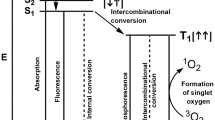Abstract
The ytterbium tetraphenyltetracyanoporphyrazine complex (YbPz) has been studied as a potential photosensitizer for fluorescence diagnostics and photodynamic therapy of cancer. A water-miscible formulation of YbPz has been prepared using PEG 6000. The new compound shows intense absorption and fluorescence in the “optical window” of biological tissues (absorption maximum ∼590 nm, emission maximum ∼625 nm). Fluorescence enhancement (a 50-fold increase in YbPz quantum yield) is observed in blood serum. In cultured human cancer cells, YbPz quickly accumulates around the nuclei, presumably in lysosomes. The distribution and pharmacokinetics of YbPz in mice have been investigated by a novel method of in vivo transillumination fluorescence imaging. The highest level of YbPz in grafted mouse cervical carcinoma is maintained from 3 to 6 h after i.v. injection, its half-life in the tumor being ∼24 h. However, the selectivity of YbPz for the tumor vs. normal tissue is not high enough. Most of the drug is cleared from the body (mainly via liver and intestine) in two days. Conventional ex vivo methods (confocal microscopy and point spectroscopic measurements) have revealed the largest content of YbPz in the intestine, liver, tumor, and skin. In general, the optical characteristics of YbPz as well as the features of its interaction with biological objects make it a promising candidate drug for photodynamic therapy and/or fluorescence diagnostics of cancer, though searching for formulations with higher tumor selectivity remains a topical task.
Similar content being viewed by others
References
N. N. Bulgakova, D. M. Yagudaev, A. E. Sorokovatyi, and A. V. Geinits, Ros. Bioterapevt. Zh. 6, 11 (2007).
E. G. Vakulovskaya, V. P. Letyagin, and E. M. Pogodina, Ros. Bioterapevt. Zh. 2, 57 (2003).
V. I. Chissov, V. V. Sokolov, N. N. Bulgakova, and E. V. Filonenko, Ros. Bioterapevt. Zh. 6, 45 (2007).
A. P. Castano, T. N. Demidova, and M. R. Hamblin, Photodiag. Photodyn. Therapy 2(2), 91 (2005).
J. J. Schuitmaker, P. Baas, H. L. van Leengoed, et al., J. Photochem. Photobiol. 34(1), 3 (1996).
K. Berg, P. K. Selbo, A. Weyergang, et al., J. Microscopy 218, 133 (2005)
V. Ntziachristos, J. Ripoll, L. V. Wang, and R. Wesslender, Nat. Biotechnol. 23, 313 (2005).
M. Shirmanova, E. Zagaynova, M. Sirotkina, et al., J. Biomed. Opt. 15, 048004 (2010).
N. B. Morozova, R. I. Yakubovskaya, V. M. Derkacheva, and E. A. Luk″yanets, Ros. Onkol. Zh., no. 1, 37 (2007).
M. R. Hamblin, M. Rajadhyaksha, T. Momma, et al., Br. J. Cancer 81(2), 261 (1999).
N. I. Kazachkina, N. N. Zharkova, G. I. Fomina, et al., Proc. SPIE 2924, 233 (1996).
Z. S. Smirnova, N. A. Oborotova, O. A. Makarova, et al., Pharm. Chem. J. 39(7), 341 (2005).
L. G. Klapshina, W. E. Douglas, I. S. Grigoryev, et al., Chem. Commun. 46, 8398 (2010).
I. V. Turchin, V. A. Kamensky, V. I. Plehanov, et al., J. Biomed. Opt. 13, 041310 (2008).
S. Bonneaua, P. Morliéreb, and D. Brault, Biochem. Pharmacol. 68, 1443 (2004).
G. M. Malham, R. J. Thomsen, G. L. Finlay, and B. C. Baguley, Br. J. Neurosurg. 10, 51 (1996).
A. B. Uzdenskii, Cellular and Molecular Mechanisms of Photodynamic Therapy (Nauka, Moscow, 2010) [in Russian].
V. N. Zalesskii and O. B. Dynnik, Ukrains’kii Medichii Chasopis 1(45), 92 (2005).
A. S. Sobolev, A. A. Rosenkranz, and Gilyazova, Biophysics 49, 337 (2004).
Author information
Authors and Affiliations
Additional information
Original Russian Text © M.V. Shirmanova, I.V. Balalaeva, N.Yu. Lekanova, S.A. Mysyagin, A.A. Brilkina, L.G. Klapshina, E.V. Zagaynova, 2011, published in Biofizika, 2011, Vol. 56, No. 6, pp. 1117–1124.
The experimental data contained herein fully correspond to the original publication but the text was substantially revised for the English version. A.G.
Rights and permissions
About this article
Cite this article
Shirmanova, M.V., Balalaeva, I.V., Lekanova, N.Y. et al. Design and testing of a new photosensitizer based on an ytterbium porphyrazine complex. BIOPHYSICS 56, 1083–1087 (2011). https://doi.org/10.1134/S0006350911060182
Received:
Published:
Issue Date:
DOI: https://doi.org/10.1134/S0006350911060182




